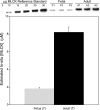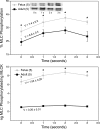Maximal stimulation-induced in situ myosin light chain kinase activity is upregulated in fetal compared with adult ovine carotid arteries
- PMID: 18835918
- PMCID: PMC2614542
- DOI: 10.1152/ajpheart.00606.2008
Maximal stimulation-induced in situ myosin light chain kinase activity is upregulated in fetal compared with adult ovine carotid arteries
Abstract
Postnatal decreases in vascular reactivity involve decreases in the thick filament component of myofilament calcium sensitivity, which is measured as the relationship between cytosolic calcium concentration and myosin light chain (MLC20) phosphorylation. The present study tests the hypothesis that downregulation of thick filament reactivity is due to downregulation of myosin light chain kinase (MLCK) activity in adult compared with fetal arteries. Total MLCK activity, calculated as %MLC20 phosphorylated per second in intact arteries during optimal inhibition of myosin light chain phosphatase activity, was significantly less in adult (6.56+/-0.29%) than in fetal preparations (7.39+/-0.53%). In situ MLC20 concentrations (microM) in adult (198+/-28) and fetal arteries (236+/-44) did not differ significantly. In situ MLCK concentrations (microM), however, were significantly greater in adult (8.21+/-0.59) than in fetal arteries (1.83+/-0.13). In situ MLCK activities (ng MLC20 phosphorylated.s(-1).ng MLCK(-1)) were significantly less in adult (0.26+/-0.01) than in fetal arteries (1.52+/-0.11). In contrast, MLCK activities in adult (15.8+/-1.5) and fetal artery homogenates (17.3+/-1.3) were not significantly different. When in situ fractional activation was calculated, adult values (1.72+/-0.17%) were significantly less than fetal values (9.08+/-0.83%). Together, these results indicate that decreased thick filament reactivity in adult compared with fetal ovine carotid arteries is due at least in part to greater MLCK activity in fetal arteries, which in turn cannot be explained by differences in MLCK, MLC20, or calmodulin concentrations. Instead, this difference appears to involve age-related differences in fractional activation of the MLCK enzyme.
Figures






References
-
- Akopov SE, Zhang L, Pearce WJ. Maturation alters the contractile role of calcium in ovine basilar arteries. Pediatr Res 44: 154–160, 1998. - PubMed
-
- Akopov SE, Zhang L, Pearce WJ. Physiological variations in ovine cerebrovascular calcium sensitivity. Am J Physiol Heart Circ Physiol 272: H2271–H2281, 1997. - PubMed
-
- Amano M, Ito M, Kimura K, Fukata Y, Chihara K, Nakano T, Matsuura Y, Kaibuchi K. Phosphorylation and activation of myosin by Rho-associated kinase (Rho-kinase). J Biol Chem 271: 20246–20249, 1996. - PubMed
-
- Belik J, Halayko AJ, Rao K, Stephens NL. Pulmonary and systemic vascular smooth muscle mechanical characteristics in newborn sheep. Am J Physiol Heart Circ Physiol 263: H881–H886, 1992. - PubMed
-
- Belik J, Kerc E, Pato MD. Rat pulmonary arterial smooth muscle myosin light chain kinase and phosphatase activities decrease with age. Am J Physiol Lung Cell Mol Physiol 290: L509–L516, 2006. - PubMed
Publication types
MeSH terms
Substances
Grants and funding
LinkOut - more resources
Full Text Sources

